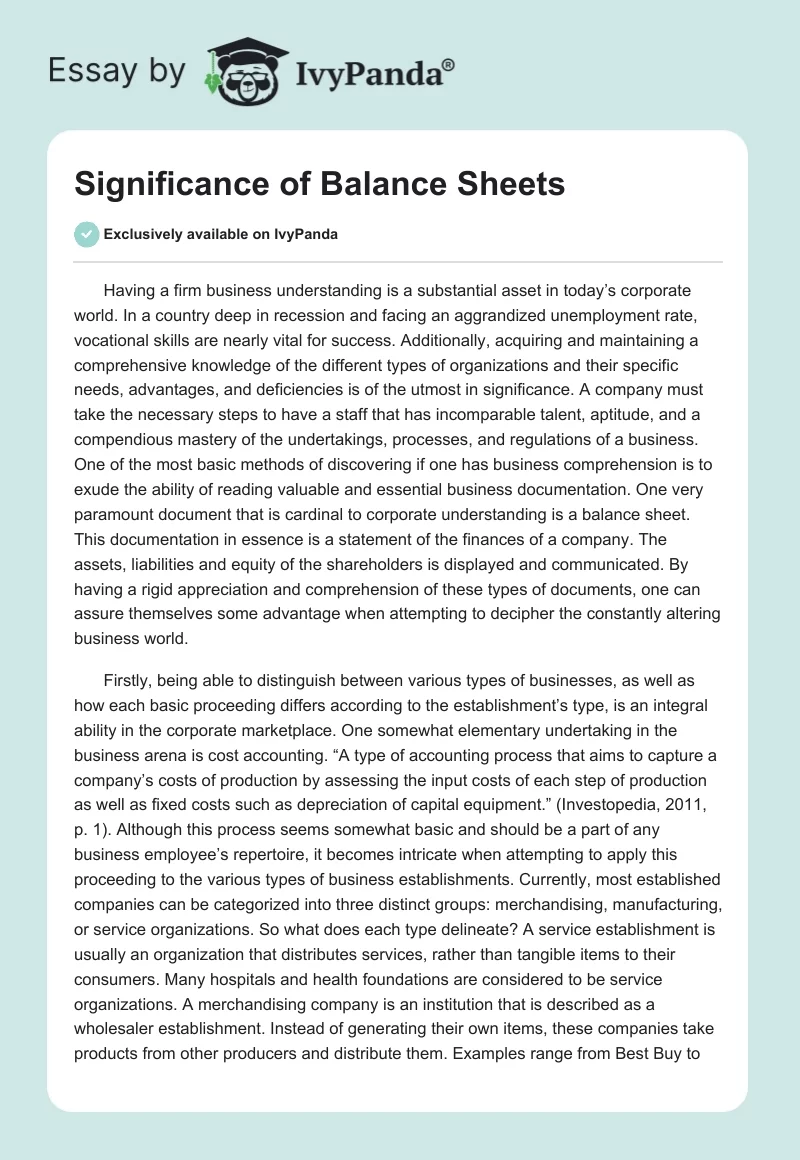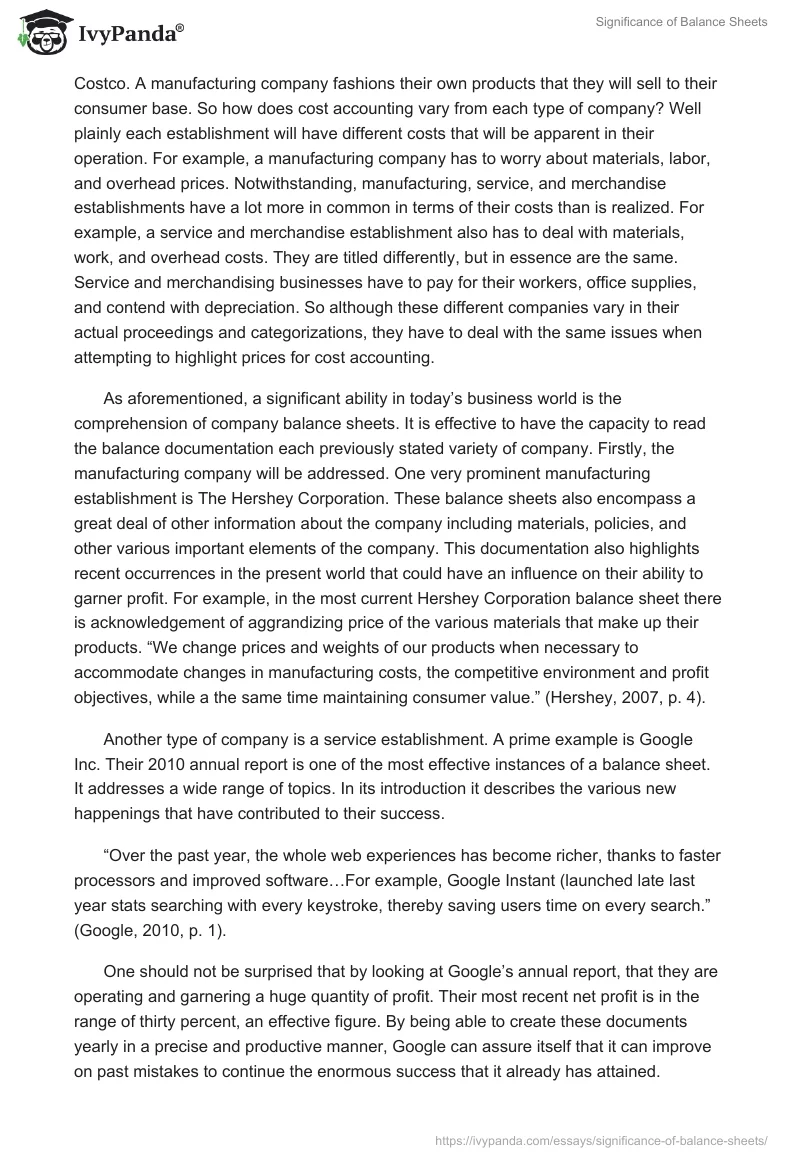Having a firm business understanding is a substantial asset in today’s corporate world. In a country deep in recession and facing an aggrandized unemployment rate, vocational skills are nearly vital for success. Additionally, acquiring and maintaining a comprehensive knowledge of the different types of organizations and their specific needs, advantages, and deficiencies is of the utmost in significance. A company must take the necessary steps to have a staff that has incomparable talent, aptitude, and a compendious mastery of the undertakings, processes, and regulations of a business. One of the most basic methods of discovering if one has business comprehension is to exude the ability of reading valuable and essential business documentation. One very paramount document that is cardinal to corporate understanding is a balance sheet. This documentation in essence is a statement of the finances of a company. The assets, liabilities and equity of the shareholders is displayed and communicated. By having a rigid appreciation and comprehension of these types of documents, one can assure themselves some advantage when attempting to decipher the constantly altering business world.
Firstly, being able to distinguish between various types of businesses, as well as how each basic proceeding differs according to the establishment’s type, is an integral ability in the corporate marketplace. One somewhat elementary undertaking in the business arena is cost accounting. “A type of accounting process that aims to capture a company’s costs of production by assessing the input costs of each step of production as well as fixed costs such as depreciation of capital equipment.” (Investopedia, 2011, p. 1). Although this process seems somewhat basic and should be a part of any business employee’s repertoire, it becomes intricate when attempting to apply this proceeding to the various types of business establishments. Currently, most established companies can be categorized into three distinct groups: merchandising, manufacturing, or service organizations. So what does each type delineate? A service establishment is usually an organization that distributes services, rather than tangible items to their consumers. Many hospitals and health foundations are considered to be service organizations. A merchandising company is an institution that is described as a wholesaler establishment. Instead of generating their own items, these companies take products from other producers and distribute them. Examples range from Best Buy to Costco. A manufacturing company fashions their own products that they will sell to their consumer base. So how does cost accounting vary from each type of company? Well plainly each establishment will have different costs that will be apparent in their operation. For example, a manufacturing company has to worry about materials, labor, and overhead prices. Notwithstanding, manufacturing, service, and merchandise establishments have a lot more in common in terms of their costs than is realized. For example, a service and merchandise establishment also has to deal with materials, work, and overhead costs. They are titled differently, but in essence are the same. Service and merchandising businesses have to pay for their workers, office supplies, and contend with depreciation. So although these different companies vary in their actual proceedings and categorizations, they have to deal with the same issues when attempting to highlight prices for cost accounting.
As aforementioned, a significant ability in today’s business world is the comprehension of company balance sheets. It is effective to have the capacity to read the balance documentation each previously stated variety of company. Firstly, the manufacturing company will be addressed. One very prominent manufacturing establishment is The Hershey Corporation. These balance sheets also encompass a great deal of other information about the company including materials, policies, and other various important elements of the company. This documentation also highlights recent occurrences in the present world that could have an influence on their ability to garner profit. For example, in the most current Hershey Corporation balance sheet there is acknowledgement of aggrandizing price of the various materials that make up their products. “We change prices and weights of our products when necessary to accommodate changes in manufacturing costs, the competitive environment and profit objectives, while a the same time maintaining consumer value.” (Hershey, 2007, p. 4).
Another type of company is a service establishment. A prime example is Google Inc. Their 2010 annual report is one of the most effective instances of a balance sheet. It addresses a wide range of topics. In its introduction it describes the various new happenings that have contributed to their success.
“Over the past year, the whole web experiences has become richer, thanks to faster processors and improved software…For example, Google Instant (launched late last year stats searching with every keystroke, thereby saving users time on every search.” (Google, 2010, p. 1).
One should not be surprised that by looking at Google’s annual report, that they are operating and garnering a huge quantity of profit. Their most recent net profit is in the range of thirty percent, an effective figure. By being able to create these documents yearly in a precise and productive manner, Google can assure itself that it can improve on past mistakes to continue the enormous success that it already has attained.
Last is a merchandising company, represented by Wal-Mart. Their balance sheet is yet again different in terms of the costs and information that it covers. Wal-Mart’s balance sheet is more focused on its borrowings and eventual profit due to these loans. One of the most significant figures that I saw in this document was its interest rate due to the loans. It was hovering around five percent, but according to the monetary quantities garnered in that year, the company is well on its way to paying back for this loaned liquidity. Furthermore, one productive aspect of Wal-Mart’s balance sheet was its acknowledgement of its accounting polices. “Wal-Mart Stores, Inc. (‘Wal-Mart,’ the ‘Company’ or ‘we’) operates retail stores in various formats around the world and is committed to saving people money so they can live better.” (Walmart, 2008, p. 1).
References
Google. (2010). 2010 Google Annual Report. Web.
Hershey. (2007). The Hershey Company. Web.
Investopedia. (2011). Cost Accounting.
Walmart. (2008). Notes to Consolidated Financial Statements. Web.


